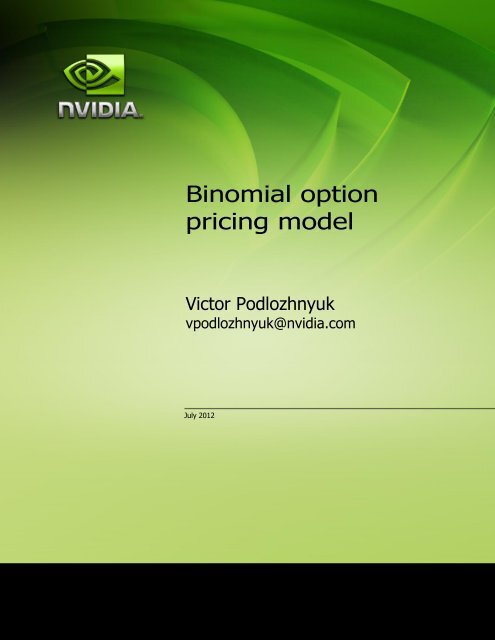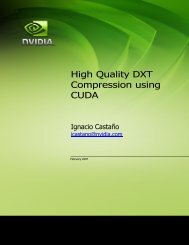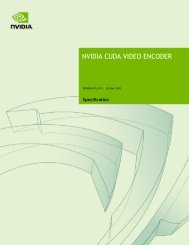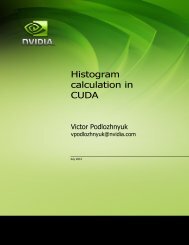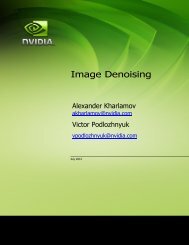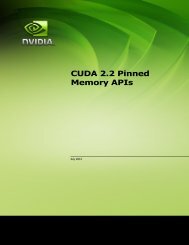Binomial option pricing model
App Note Template - nVIDIA CUDA Toolkit Documentation
App Note Template - nVIDIA CUDA Toolkit Documentation
- No tags were found...
Create successful ePaper yourself
Turn your PDF publications into a flip-book with our unique Google optimized e-Paper software.
<strong>Binomial</strong> <strong>option</strong><br />
<strong>pricing</strong> <strong>model</strong><br />
Victor Podlozhnyuk<br />
vpodlozhnyuk@nvidia.com<br />
July 2012
Document Change History<br />
Version Date Responsible Reason for Change<br />
0.9 2007/03/19 vpodlozhnyuk Initial release<br />
1.0 2007/04/05 Mharris Grammar and clarity fixes.<br />
July 2012
Abstract<br />
The <strong>pricing</strong> of <strong>option</strong>s is a very important problem encountered in financial engineering<br />
since the creation of organized <strong>option</strong> trading in 1973. As more computation has been<br />
applied to finance-related problems, finding efficient ways to implement <strong>option</strong> <strong>pricing</strong><br />
<strong>model</strong>s on modern architectures has become more important. This sample shows an<br />
implementation of the binomial <strong>model</strong> in CUDA.<br />
NVIDIA Corporation<br />
2701 San Tomas Expressway<br />
Santa Clara, CA 95050<br />
www.nvidia.com
Introduction<br />
The most common definition of an <strong>option</strong> is an agreement between two parties, the <strong>option</strong><br />
seller and the <strong>option</strong> buyer, whereby the <strong>option</strong> buyer is granted a right (but not an obligation),<br />
secured by the <strong>option</strong> seller, to carry out some operation (or exercise the <strong>option</strong>) at some<br />
moment in the future. The predetermined price is referred to as strike price, and future date is<br />
called expiration date. (See Kolb & Pharr. [1])<br />
Options come in several varieties:<br />
A call <strong>option</strong> grants its holder the right to buy the underlying asset at a strike price at some moment<br />
in the future.<br />
A put <strong>option</strong> gives its holder the right to sell the underlying asset at a strike price at some moment<br />
in the future.<br />
There are several types of <strong>option</strong>s, mostly depending on when the <strong>option</strong> can be exercised.<br />
European <strong>option</strong>s can be exercised only on the expiration date. American-style <strong>option</strong>s are<br />
more flexible as they may be exercised at any time up to and including expiration date and as<br />
such, they are generally priced at least as high as corresponding European <strong>option</strong>s. Other<br />
types of <strong>option</strong>s are path-dependent or have multiple exercise dates (Asian, Bermudian).<br />
For a call <strong>option</strong>, the profit made at exercise date is the difference between the price of the<br />
asset on that date and the strike price, minus the <strong>option</strong> price paid. For a put <strong>option</strong>, the<br />
profit made at exercise date is the difference between the strike price and the price of the<br />
asset on that date, minus the <strong>option</strong> price paid.<br />
The price of the asset at expiration date and the strike price therefore strongly influence how<br />
much one would be willing to pay for an <strong>option</strong>.<br />
Other important factors in the price of an <strong>option</strong> are:<br />
The time to the expiration date, T: Longer periods imply wider range of<br />
possible values for the underlying asset on the expiration date, and thus more<br />
uncertainty about the value of the <strong>option</strong>.<br />
The riskless rate of return, r, which is the annual interest rate of bonds or<br />
other ―risk-free‖ investment: Any amount P of dollars is guaranteed to be worth<br />
rT<br />
P e dollars T years from now if placed today in one of theses investments or<br />
in other words, if an asset is worth P dollars T years from now, it is worth<br />
rT<br />
P e<br />
today.<br />
This example demonstrates a CUDA implementation of the binomial <strong>model</strong> for European<br />
<strong>option</strong>s.<br />
July 2012
<strong>Binomial</strong> <strong>option</strong> <strong>model</strong><br />
The binomial <strong>option</strong> <strong>pricing</strong> <strong>model</strong> is an iterative solution that <strong>model</strong>s the price evolution<br />
over the whole <strong>option</strong> validity period. For some types of <strong>option</strong>s, such as the American<br />
<strong>option</strong>s, using an iterative <strong>model</strong> is the only choice since there is no known closed-form<br />
solution that predicts price over time.<br />
More precisely, the binomial <strong>model</strong> represents the price evolution of the <strong>option</strong>’s underlying<br />
asset as the binomial tree of all possible prices at equally-spaced time steps from today under<br />
the assumption that at each step, the price can only move up and down at fixed rates and<br />
with respective pseudo-probabilities p<br />
u<br />
and p<br />
d<br />
. In other words, the root node is today’s<br />
price, each column of the tree represents all the possible prices at a given time, and each<br />
node of value S has two child nodes of values u S and d S , where u and d are the<br />
factors of upward and downward movements for a single time-step dT .<br />
v<br />
dT v<br />
dT<br />
u and d are derived from volatility v : u e , d e ;( u d 1)<br />
.<br />
p<br />
d<br />
is simply equal to 1 pu<br />
and p<br />
u<br />
is derived from the assumption that over a period of<br />
dT the underlying asset yields the same profit as a riskless investment on average, so that if<br />
rdT<br />
it is worth S at time t , then it is worth S e at time t dT . This leads to the following<br />
rdT<br />
equation: S e<br />
( pu<br />
u<br />
S (1 pu<br />
) d S)<br />
, from which we deduce p<br />
u<br />
:<br />
p<br />
u<br />
S<br />
rdT<br />
e d<br />
<br />
u d<br />
dS<br />
uS<br />
d 2 S S u 2 S<br />
d 3 S<br />
d 4 S<br />
dS uS u 3 S<br />
d 2 S S u 2 S<br />
u 4 S<br />
Figure 1. <strong>Binomial</strong> tree for 4 time steps. u d 1<br />
July 2012
From the binomial tree representation, we can then iteratively derive the <strong>option</strong> price for<br />
each node of the tree, starting at the leaves. At each leaf of the tree (i.e. at <strong>option</strong> expiry)<br />
deriving call and put <strong>option</strong> price is simple:<br />
V call<br />
max( S X,0) : Indeed, if market price S at expiry date is greater than strike price<br />
X , a call <strong>option</strong> returns its holder S X dollars of profit — for a same-day sale<br />
transaction — or zero profit otherwise.<br />
V put<br />
max( X S,0) : Similarly, if market price S at expiry date is lower than strike<br />
price X , a put <strong>option</strong> gives its holder<br />
X S dollars of profit, or zero profit otherwise.<br />
Having calculated all possible <strong>option</strong> prices at expiry date, we start moving back to the root,<br />
rdT<br />
using the following formula: Vt<br />
( pu<br />
Vu, t1<br />
pd<br />
Vd<br />
, t1)<br />
e<br />
, where V<br />
t<br />
is the <strong>option</strong><br />
price for one of the nodes at time t and V<br />
u, t1<br />
and V<br />
d , t1<br />
are the prices of its two child<br />
nodes. This formula is derived from the observation that an <strong>option</strong> that is worth V<br />
t<br />
at time<br />
rdT<br />
t , is worth at time t dT , V t<br />
e on one hand, and its expected value on the other<br />
hand, which is p<br />
u<br />
Vu, t1<br />
pd<br />
Vd<br />
, t1<br />
, by definition.<br />
Implementation details<br />
CPU implementation<br />
Having calculated all the quotients by the formulas given above, implementation of binomial<br />
tree tracking on the CPU is fairly easy. At first, all leaf values have to be generated as shown<br />
in Listing 1.<br />
for(int i = 0; i 0; i--)<br />
for(int j = 0; j
i = 1<br />
i = 2<br />
...<br />
...<br />
...<br />
...<br />
...<br />
...<br />
...<br />
...<br />
i = NUM_STEPS - 1<br />
i = NUM_STEPS<br />
NUM_STEPS + 1<br />
Figure 2. Successive reduction of the prices array.<br />
GPU implementation<br />
On parallel architectures such as the NVIDIA G80 GPU, a more robust computation<br />
scheme has to be developed, since everything is different on GPUs: there are many physical<br />
devices executing instructions in parallel as well as constraints on memory access patterns.<br />
A straightforward approach would be to load all leaf values into a high-speed shared<br />
memory buffer and perform calculations in shared memory. But the size of shared memory<br />
on the G80 GPU is limited. So, we take as basis our intention to store as many data as<br />
possible in shared memory, but taking into account that working data sizes can be much<br />
larger than the available shared memory, forcing us to spill to global memory at some steps<br />
of the computation.<br />
July 2012
The solution is to process nodes of the tree in portions that fit into shared memory.<br />
Looking at the reference CPU implementation, we can see that only the values at nodes [A ..<br />
B] at time step T are needed to derive the values at nodes [A .. B – 1] at time step T – 1 and<br />
on down the tree to nodes [A .. B – D] at time step T – D.<br />
This primitive, reducing nodes from [A .. B] to [A .. B – CACHE_DELTA] (B – A
CACHE_STEP<br />
CACHE_STEP<br />
...<br />
...<br />
CACHE_DELTA CACHE_DELTA CACHE_DELTA CACHE_DELTA<br />
Figure 4: Applying reduction primitive to the entire prices array.<br />
In addition, since the order of thread scheduling is complex and best viewed as simply<br />
undefined, the reduction primitive is double-buffered, ensuring by means of __syncthreads()<br />
that results from the previous stage are ready before they are used in the next, as shown in<br />
Listing 3.<br />
//Calculations within shared memory<br />
for(int k = c_start - 1; k >= c_end;){<br />
//Compute discounted expected value<br />
__syncthreads();<br />
if(tid
Bibliography<br />
1. Craig Kolb, Matt Pharr (2005). "Option <strong>pricing</strong> on the GPU". GPU Gems 2. Chapter 45.<br />
2. Fischer Black, Myron Scholes (1973). "The Pricing of Options and Corporate<br />
Liabilities". Journal of Political Economy 81 (3): 637-654.<br />
July 2012
Notice<br />
ALL NVIDIA DESIGN SPECIFICATIONS, REFERENCE BOARDS, FILES, DRAWINGS, DIAGNOSTICS, LISTS, AND<br />
OTHER DOCUMENTS (TOGETHER AND SEPARATELY, “MATERIALS”) ARE BEING PROVIDED “AS IS.” NVIDIA<br />
MAKES NO WARRANTIES, EXPRESSED, IMPLIED, STATUTORY, OR OTHERWISE WITH RESPECT TO THE<br />
MATERIALS, AND EXPRESSLY DISCLAIMS ALL IMPLIED WARRANTIES OF NONINFRINGEMENT,<br />
MERCHANTABILITY, AND FITNESS FOR A PARTICULAR PURPOSE.<br />
Information furnished is believed to be accurate and reliable. However, NVIDIA Corporation assumes no<br />
responsibility for the consequences of use of such information or for any infringement of patents or other<br />
rights of third parties that may result from its use. No license is granted by implication or otherwise under any<br />
patent or patent rights of NVIDIA Corporation. Specifications mentioned in this publication are subject to<br />
change without notice. This publication supersedes and replaces all information previously supplied. NVIDIA<br />
Corporation products are not authorized for use as critical components in life support devices or systems<br />
without express written approval of NVIDIA Corporation.<br />
Trademarks<br />
NVIDIA, the NVIDIA logo, GeForce, NVIDIA Quadro, and NVIDIA CUDA are trademarks or<br />
registered trademarks of NVIDIA Corporation in the United States and other countries. Other<br />
company and product names may be trademarks of the respective companies with which they<br />
are associated.<br />
Copyright<br />
© 2007-2012 NVIDIA Corporation. All rights reserved.<br />
July 2012


